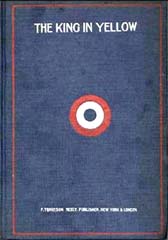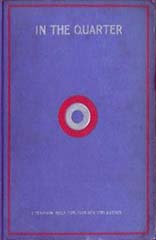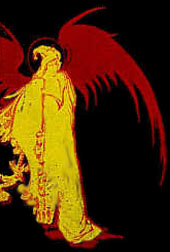...
There is long-standing battle over
which of the editions is actually the true first edition. This is
a continuing question and we have not yet seen someone with strong proof
one way or another.
The book was published in 1895.
  There
are those who feel that the Neely's Prismatic Library was the first edition
(Salamander) and others who feel that the similar edition with the butterfly
on the back is the actual first edition. There
are those who feel that the Neely's Prismatic Library was the first edition
(Salamander) and others who feel that the similar edition with the butterfly
on the back is the actual first edition.
What is probably the most compelling
evidence for which is which is the change in text between the two versions.
This text change makes the Salamander version stand alone from the Butterfly
version despite the fact that the Butterfly version has thicker, better
paper and the feel of a cut paper edition.
Letter 1:
 From:
ESIBJones.@.aol.com From:
ESIBJones.@.aol.com
DATE: Thu, 29 Jun 2000 14:30 EDT
I have a copy of the first printing of 'The King in Yellow' and so was
surprised and disappointed to find that in your rendering of 'The Yellow
Sign'. You appear to have deliberately inserted words that do not appear
in the original. Specifically, at the very end of the story -- Tessie's
soft cry and her spirit fled. End of sentence. Not, as you have it, "fled
to God." The next sentence ends -- there was only God to cry to now --
not, "there was only Christ to cry to now." I believe this mistake to be
purposeful on your part and am curious in consequence as to why you found
need to interfere with the reprinting of a masterpiece. --
Looking forward to your reply
Barry Jones
|
 Dear
Barry, Dear
Barry,
Actually, there is a large question about the two versions. There
are two printings of the book, both claiming 1895 first edition status.
Both are printed by the same company but one, the green "The Neely's Prismatic
Library" version with the salamander on the cover is believed to be the
original.
The Salamander cover version of the short story The Yellow Sign contains
the lines: "Then, as I fell, I heard Tessie's soft cry and her spirit
fled to God, and even while falling I longed to follow her, for I knew
that the King in Yellow had opened his tattered mantle and there was only
Christ to cry to now."
The Butterfly cover version (and all subsequent versions) change the
lines to: "Then, as I fell, I heard Tessie's soft cry and her spirit
fled, and even while falling I longed to follow her, for I knew that the
King in Yellow had opened his tattered mantle and there was only God to
cry to now."
Despite the newer versions, we have opted to print the Salamander cover
version, since it appears to be the author's original words. It was
perhaps, at the time, an editor's fear that the book might be perceived
as heretically anti-Christian. Therefore the subsequent versions
have dropped the reference to Tessie's soul fleeing to "God" and replaced
"Christ" with the less specific "God." The butterfly version is the
one you seem to have.  If
you come across the version with the King in Yellow depicted with wings
on the cover you will see that it agrees with the butterfly version. If
you come across the version with the King in Yellow depicted with wings
on the cover you will see that it agrees with the butterfly version.
 ... ... I have not personally checked the version with the bull's eye (French rondel)
or the Memorial version from the 1930's. But I suspect that they
also present the butterfly version. In our version we are attempting
to fulfill the original author's wording. We have put up a notice
in the text which refers to this page and the discussion of which wording
is correct. Anyway, that is why we have the current version on the
electronic site. Thanks for bringing this up. Let us know which
version the book you have (mainly by cover, if there is an tipped in photo
of the author, and if there is advertising tipped into the back).
We intend to put an article on this on line shortly to continue the debate.
I have not personally checked the version with the bull's eye (French rondel)
or the Memorial version from the 1930's. But I suspect that they
also present the butterfly version. In our version we are attempting
to fulfill the original author's wording. We have put up a notice
in the text which refers to this page and the discussion of which wording
is correct. Anyway, that is why we have the current version on the
electronic site. Thanks for bringing this up. Let us know which
version the book you have (mainly by cover, if there is an tipped in photo
of the author, and if there is advertising tipped into the back).
We intend to put an article on this on line shortly to continue the debate.
Best wishes,
Donald Clarke
Miskatonic University Pres
|
Letter 2:
 From:
kalex.@.umich.edu From:
kalex.@.umich.edu
Date: Thu, 1 Aug 2002 21:55:18 -0400 (EDT)
To: rwchambers@yankeeclassic.com
Subject: KIY versions
I have the dark blue "bullseye" cover of KIY
(with author photo in front and advertising in back), so I can contribute
two very tiny pieces of information about it.
Regarding
http://www.yankeeclassic.com/miskatonic/libscien/covers/1edcontr.htm
"The Yellow Sign" contains the "only God to cry to now" wording rather
than the "Christ" wording, and the final sentence ends abruptly. So the
bullseye wording matches your description of the butterfly wording.
Regarding http://www.miskatonicuniversitypress.com/miskatonic/dliterature/
authors/chambers/works/kiy1sted.htm
My copy contains a handwritten inscription:
to Edward from Cousin Bertha July
20, 1899
If genuine, it puts an upper bound on the bullseye publication date.
Respectfully,
kalex.@.umich.edu
|
 Dear
kalex.@.umich.edu, Dear
kalex.@.umich.edu,
There appears to be a matching edition of "In the Quarter" and "The
King in Yellow" with the same bullseye on the cover. The bullseye
is actually the "French Rondel," a military symbol developed from the French
flag and used to mark military planes and vehicles to signify the origin
country. It appears that among the many reprints of RWC's work, the
first two books were reprinted as a set. The French symbol is appropriate
since both have French settings. This was also done later with RWC's
historical and society novels.
 .. ..
What we don't know is the date of this matched
set.
Donald Clarke
Miskatonic University Press
|
Letter 3:
 From:
Harold Billings <billings.@.mail.utexas.edu> From:
Harold Billings <billings.@.mail.utexas.edu>
Subject: King in Yellow publication priorities
Wed, 12 Nov 2003
These holdings of "The King in Yellow" in the Ransom Center of the University
of Texas at Austin suggest the "butterfly" edition existed as early as
August 1895. What this might mean in connection with the wording
change between the two "editions" of "The Yellow Sign" is anyone's guess.
(It is conceivable that the listing of these two "editions" or "issues"
(mistakenly combined as one) is wrong.) --HB
 
HRC cops.1-6: Advertisements: (2) p. at end.
HRC cops.1-6: bound in green cloth; stamped in brown.
Cops.1-3,5: have monogrammed stamp in brown on front cover and a frontispiece.
Cops.4-6,8: have variant stamp in brown on front cover and no frontispiece.
HRC cop.1: (CUR) HRC bookplate: The L.W. Currey Science Fiction and
Fantasy Collection.
Cop.2: UT bookplate: The Henry and Mollie Cohen Library; inscribed
to Dr. H. Cohen from Lallah R. Block, June 30, '97.
Cop.3: Presentation copy of the publisher, 12th August 1895; signed
by the author.
Cop.4: Inscribed: Thomas Curley.
Cop.5: Inscribed: E.G. Richards.
Cop.6: (GRO) Ex libris John Stuart Groves; bookplate on front pastedown
(tipped in by HRC); armorial bookplate of the author with his signature
(tipped in by HRC).
Cop. 7-8: (MCU) Ex libris George Barr McCutcheon.
Cop.7: rebound in brown morocco.
Cop.8: Author's ALS to George Barr McCutcheon, dated March 19, 1916
(tipped in); in dark green slipcase; Reg. no.1464.
--
Harold Billings
1807 Glencliff Drive
Austin, TX 78704
billings.@.mail.utexas.edu
|
I am certain that there are interested
parties who will prove either theory and, hopefully, someone who has the
final and definitive answer. And it would be interesting to know
if the change came from the author or the editor. Perhaps someone
will find a criticism of the book and the reference to "Christ" which caused
the editorial decision to change the work between the first and escond
editions. It certainly would knock the bookselling world on their
ear if someone were to prove the traditional thinking wrong. If anyone
has more information on this subject, please feel free to contact us at
RWChambers@miskatonicuniversitypress.com.
|

